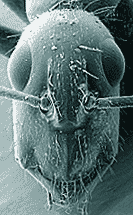Filed under: Great websites / blogs | Tags: Ant, Entomology, Museum collection, Myrmecology
Just want to share the address of a website I found this morning and I simply loved.

The Royal Belgium Institute of Natural Sciences has a website dedicated to the ants of Paraguayan Chaco: RBINS Ant eMuseum. The website is developed by a team led by the Belgium entomologist Maurice Leponce and the French entomologist Thibaut Delsinne. The website offers access to the records of the species collected in Paraguay with details for the different specimens and tons of microscopic pictures. The design is very neat and the navigation on the website really pleasant.
But to me the real treasure of this website is an excellent glossary which is richly illustrated with amazing pictures. Probably the best anatomical glossary I have seen so far! Thank you for this useful tool.
The website also offers an interactive identification key and description of the different project. I am looking forward to see the future developments…
Finally, if you want to learn more about the ants of Paraguay don’t miss the work made by the entomologist and photographer Alex Wild (aka Myrmecos) on Antweb and its catalog of the ants of Paraguay published in 2007 in Zootaxa.
One last thing. Take some time to look at the animation that I borrow from the RBINS Ant eMuseum homepage, a surprise is awaiting you with the Camponotus.
Species and genus names are often repulsive for many students, and the picture below illustrates probably how a young student would dream his pathway in biology.

However, names often have a function and/ or a story. This is what I would like to talk about today.
Species names can have a specific function which is to carry some information relative to the species itself. For example, it can provide information on the color, such as in Lasius niger (niger in latin means black), the morphology (Pheidole megacephala = giant head), the size (Plagiolepis pygmaea), the behavior or ecology (Camponotus sylvaticus, sylva means forest in latin), on the provenance (Brachymyrmex patagonicus, from Patagonia in Argentina),…
But it can also be more personal, …
Often the author chooses a name in homage to someone else. Most of the time this is one of their colleague or less often a member of their family. For example the new world genus Forelius was described in 1888 by the Italian myrmecologist Carlos Emery in honor of the Swiss Auguste Forel, and a few years later, in 1912 Forel described the new Oriental genus Emeryopone (can you guess in honor of who?). One more example with the beautiful African genus Santschiella described by Auguste Forel in 1916 probably in honor of the Italian myrmecologist Felix Sanstchi. Some other obvious genera names dedicated to myrmecologists are Bondroitia, Mayriella, Rogeria, or Wasmannia.
However, sometimes the species name is more surprising. For example today, I went through Pheidole harrisonfordi described by E.O. Wilson in 2003. It first made me laugh, but then I learned, thanks to my colleague Mike Weiser, that Harrison Ford was really involved into conservation, especially with Conservation International. I found these two links that describes a little more the reason why Han Solo deserved an ant species dedicated: CI link 1; and CI link 2
Another story which was famous a few years ago was the description by Brian Fisher in 2005 of a new ant from Madagascar: Proceratium google. More info available on the official Google blog.
An other ant name that I like is the east European ant, Bothriomyrmex communista, described by Santschi from a specimen collected in Crimea (Russia) in 1919. Two years after the Bolshevik revolution in October 1917. Who said that History and Biology could not get along with each other?
Finally a name that has intrigued me at some point was Stenamma debile. In French (my native language), “debile” means stupid/ idiot. I thought that maybe A. Forster, the myrmecologist that described this species, was upset the day he described the species and decided to pass his frustration on the subject of his research. The fact is that in Latin, “debile” means weak, and so it refers probably to the morphology of the ant than its intellectual capacity! And when I looked at the picture of S. debile, it can be perceived as a sort of fragile ant.
Let me know if you have more anecdotes or some name that you prefer for some reasons.
Filed under: Thoughts
Yesterday morning, when I parked my car in the university parking deck I noticed that the car just beside mine add a sticker that for one time would make me jealous. I usually don’t care for car stickers and North Carolina has probably the world records for the number of car stickers per habitant (and more often I would prefer don’t see them). Anyway this time the sticker said: ” Save the ants”
What? a sticker dedicated to the object of my deep passion. Believe me, I even thought to take some time to remove it from the car to put it on mine. But finally this thought cross my brain for less than 0.2 second and I finally resigned.
Anyway, here is a picture of the sticker I saw yesterday that I was able to track on internet. This one was found on a door of a fridge… I should put one in my kitchen which is invaded every summer by the odorous house ant, Tapinoma sessile, that my girlfriend forces me to kill (she loves ants but not in our kitchen).

Filed under: Thoughts
I have to say, that Internet is a fantastic tool (that’s obvious, I know) to look for articles and records. However, sometimes it can be a bit frustrating. Here is why.
Now that the maps are done (even if they are still evolving), I like once in a while, or often, to try to track some interpolations that I have made (in blue), to see if eventually they could turn as a real record (in green). Usually, the research in Google is straight forward. Imagine to search for Amblyopone in Algeria (which I am still looking for), and Google scholar will return 13 links (which unfortunately did not work ). Now let’s imagine that you want to look for Azteca in Yucatan, and this time, you will see 4860 results which have nothing to do with myrmecology, but more with History (fabulous subject but pointless in my research). Ahhhhh Misere!
Hopefully, this is very rare, and as Azteca was described in 1878, by the Swiss myrmecologist August Forel, I think I can forgive him 🙂 . Especially if I add Formicidae into my Google research which turn to give me finally only 43 results. So everything is doing well, and let’s the genera hunting continue in the abyss of Internet.
When I started monitoring the generic distribution of ants I had two goals: 1) obtain an idea of the generic richness and assemblage by regions, and 2) obtain a distribution map as accurate as possible for each extant genus. Well, very quickly I have been confronted to a major problem in those two goals with the presence of exotic genera around the globe. Humans have been extremely successful (not necessarily a good thing) in dispersing exotic species all around the planet; and this is a now a problem when we try to understand patterns of diversity if we don’t discriminate between native and exotic taxa.
So beside the generic database, I have created a second one for the exotic species. Some good reviews have been made in the past on the frequency of ant introductions (McGlynn 1999, Suarez et al. 2005, Ward et al. 2006), on exotic species of specific locations (take a list of ants in Hawaii that are all introduced, list for Florida, Netherland,…), or on specific species (Wetterer 2007, 2008, Wetterer et al. 2009, …). However, there is still a few cases where boundaries, native regions are not clearly identified (e.g. Tapinoma melanocephalum, see Wetterer 2009). To add to the confusion, some exotic species or some tramp species have been described from their introduced range prior to be identified in their native range.
My goal, as I said was to identify the native range of genera and not to make a catalog of all the introduced regions for a given taxa (even if I expect to reach such result in the future). So the generic map have to be handle with precaution concerning the exotic genera. Here is in a few point what information is irrelevant and which one is not.
– If you look for all the locations where a genus has been introduced, those maps will provide part of information but the referencing in this case was not exhaustive.
– The maps are at the generic level, so the presence of native species in a region (in green) will eclipse the potential presence of an exotic genus (in orange). For example, you can notice that no regions of the South East USA are in orange, where Solenopsis invicta has been introduced because native species such as Solenopsis molesta are found in the same regions.

Distribution of the Solenopsis genus
– At the opposite, in a few case, the genus might be present, but not found yet (or I should say that I did not find a record for it), but an exotic species have been found. So the region is in orange, but could also be in blue.
I hope that this post will clarify the extant to which the exotic genera can be perceived in the distribution maps, and as I update the maps regularly, the gaps for exotic presence should be filled progressively.
450. That’s not the title of a neo peplum for body-builders, but the number of new generic records that have been added to our database, and so to the maps, since we started the website last May.
This has been possible thanks to the help of some myrmecologists that sent me papers that I did not know (thank you!), new articles published, such as a list of the ants of Tabasco (Del Toro et al. 2009), and also because I tried to track deep into some journals and books to find some more data (I don’t want to read anymore Chinese book on ants for the next week). Add to this, 5 new genera that have been described, and you get the count. I should not forget to add a few records from Laos that one of undergrad student (I wish everyone to have one like her working with you) brought me back from a trip she did in Asia.
The good thing about it, is that most of them had been predicted to be present (blue on maps) in the previous version, several were uncertain, and for one of them was predicted as absent (shame on me, but 1 on 450 it is 0.2% of mistake, so it is not that bad).
The changes concern 135 genera (about 45% of the extant genera), and the maps are now updated on the website!
Hopefully, in a few months, I could make a post untitled 500!
Well, here is the first post of Ant Genera of the World’ blog edition. This blog is related to the website: http://www.antmacroecology.org/ant_genera/index.html
On Ant Genera of the World, the website, we present our maps of distribution of the 297 extant genera of ants. On this blog, I will present the new updates made on the maps, the new genera added (5 new genera have been described since we launch the website last April, pretty impressive!), the acknowledgments to contributors and to all the people that have play a major role in this project (I can start now with a first thank you), and any other topics related to our knowledge on ants distribution.
Since we started the website, the 5th May 2009, we have received a lot of supportive messages and many people have expressed their interests for such maps. Well, this is to me the best reward to know that this work has been and will be helpful to the myrmecologist community.
Before to start will the different posts, I would like to give some special acknowledgments for those of you who have helped to add data, to correct some mistakes, or who provided me with literature. Thank you so much for your contribution.